问题1.在∆ ABC中,在B处成直角,AB = 24厘米,BC = 7厘米。决定 :
(i)罪A,cos A(ii)罪C,cos C
解决方案:

Using Pythagoras theorem for ΔABC
AC2 = AB2 + BC2
= (24 cm)2 + (7 cm)2
= (576 + 49) cm2
= 625 cm2
∴AC = 25 cm
(i) sin A = opp/hyp
sin A = 7/25
cos A = adj/hyp = 24/25
cos A = 24/25
(ii) sin C = opp/hyp
sin C = 24/25
cos C = adj/hyp
cos C = 7/25
问题2。在图8.13中,找到tan P – cotR。
解决方案:
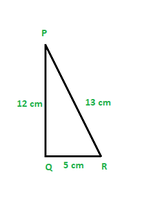
Applying Pythagoras theorem for ΔPQR, we obtain
PR2 = PQ2 + QR2
(13 cm)2 = (12 cm)2 + QR2
169 cm2 = 144 cm2 + QR2
25 cm2 = QR2
QR = 5 cm
tan P = opp/adj
tan P = 5/12
cot R = adj/opp
cot R = 5/12
tan P – cot R = 5/12 – 5/12 = 0
问题3.如果sin A = 3/4,则计算cos A和tanA。
解决方案:
Using sin2A + cos2A = 1
(3/4)2 + cos2A = 1
cos2A = 1 – (3/4)2 = 1 – 9/16
cos A = 71/2/4
tan A = sin A/cos A
tan A = (3/4)/(71/2/4)
tan A = 3/71/2
问题4:给定15 cot A =8。求正A和sec A
解决方案:
Given, 15 cot A = 8
cot A = 8/15
tan A = 1/cot A
tan A = 15/8
Using, 1 + tan2A = sec2A
1 + (15/8)2 = sec2A
289/64 = sec2A
sec A = 17/8
We know, cos2A = 1/sec2A
cos2A = 64/289
sin2A = 1 – cos2A
sin2A = 225/289
sin A = 15/17
问题5:给定秒θ = 13/12,计算所有其他三角比。
解决方案。
Using Pythagoras theorem,
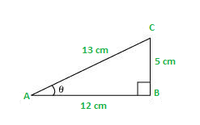
sin θ = 5/13
cos θ = 12/13
tan θ = 5/12
cosec θ = 13/5
cot θ = 12/5
问题6:如果∠A和∠B是锐角,使得cos A = cos B,则证明∠A=∠B。
解决方案:
让我们考虑其中CD⊥AB的ΔABC。
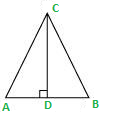
假设cos A = cos B
AD / AC = BD / BC…(1)
我们需要证明∠A=∠B。为了证明这一点,我们需要将AC扩展到P,使得BC = CP。

From equation (1), we obtain
AD/BD = AC/BC
AD/BD = AC/CP (BC = CP by construction)
By using the converse of B.P.T (Basic Proportionality Theorem),
CD||BP
∠ACD = ∠CPB (Corresponding angles) … (3)
And, ∠BCD = ∠CBP (Alternate interior angles) … (4)
By construction, we have BC = CP.
∴ ∠CBP = ∠CPB (Angle opposite to equal sides of a triangle) … (5)
From equations (3), (4), and (5), we obtain
∠ACD = ∠BCD … (6)
In ΔCAD and ΔCBD,
∠ACD = ∠BCD (Using equation (6))
∠CDA = ∠CDB (Both 90°)
Therefore, the remaining angles should be equal.
∴∠CAD = ∠CBD
⇒ ∠A = ∠B
问题7:如果cotθ = 7/8,则求值
(i)(((1 + sinθ )*(1 –sinθ))/(1 +cosθ)*(1-cosθ )))
(ii)婴儿床2θ
解决方案:
(i) Using (a + b) * (a – b) = a2 – b2 in numerator and denominator
We get
(1 – sin2θ)/(1 – cos2θ)
Using sin2θ + cos2θ = 1
We get
cos2θ/sin2θ = cot2θ
Now
cot2θ = (7/8)2 = 49/64
(ii) cot2θ = (7/8)2 = 49/64
问题8.如果3 cot A = 4,请检查(1 – tan 2 A)/(1 + tan 2 A)= cos 2 A – sin 2 A
解决方案。
We know that, tanA = sinA / cosA ….(1)
Using (1) on L.H.S
= (1 – sin2A/cos2A)/(1 + sin2A/cos2A)
which on rearranging becomes
= (cos2A – sin2A)/(cos2A + sin2A)
Using the identity,
cos2A + sin2A = 1
LHS becomes
= (cos2A – sin2A)
This is equal to RHS.
LHS = RHS (for every value of cot A)
Hence, Proved.
问题9:在ΔABC中,与B成直角。如果tan A = 1 /(3 1/2 ),则求出
(i)罪A cos C +罪A A sin C
(ii)cos A cos C − sin A sin C
解决方案:
Using Pythagoras theorem
(AB)2 + (BC)2 = (AC)2
(31/2)2 + (1)2 = (AC)2
which gives
AC = 2 cm
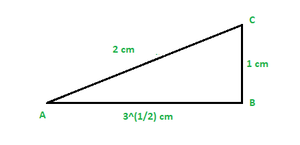
Using formulas
sin A = 1/2
sin C = 31/2/2
cos A = 31/2/2
cos C = 1/2
Now, (i) sin A cos C + cos A sin C
Substituting the values
= (1/2) * (1/2) + (31/2/2) * (31/2/2)
= 1/4 + 3/4
= 1
Now, (ii) cos A cos C − sin A sin C
Substituting the values
= (31/2/2) * (1/2) – (1/2) * (31/2/2)
= 31/2/4 – 31/2/4
= 0
问题10:在ΔPQR中,与Q成直角,PR + QR = 25 cm,PQ = 5 cm。确定sin P,cos P和tan P的值。
解决方案:
Given that, PR + QR = 25
PQ = 5
Let PR be x cm.
Therefore, QR = 25 − x cm

Applying Pythagoras theorem in ΔPQR, we obtain
PR2 = PQ2 + QR2
x2 = (5)2 + (25 − x)2
x2 = 25 + 625 + x2 − 50x
50x = 650
x = 13
Therefore, PR = 13 cm
QR = (25 − 13) cm = 12 cm
Now,
sin P = QR/PR = 12/13
cos P = PQ/PR = 5/13
tan P = QR/PQ = 12/5
问题11。说明以下是对还是错。证明你的答案。
(i)tan P的值始终小于1。
(ii)对于某个角度A值,sec A = 12/5。
(iii)cos A是角度A的余割线的缩写。
(iv)婴儿床A是婴儿床和A的乘积
(v)对于某个角度θ,sinθ= 4/3
解决方案:
(i) Consider a ΔPQR, right-angled at Q as shown below.
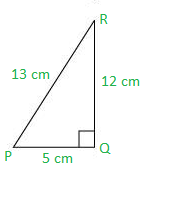
Here tan P = 12/5 which is surely greater than 1.
Therefore, the statement is false.
(ii) Consider ΔABC with AB = 5 cm, AC = 12 cm and BC = x cm
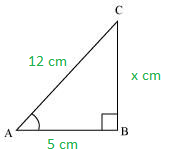
Using Pythagoras theorem in ΔABC
(AB)2 + (BC)2 = (AC)2
52 + x2 = 122
x = (144 – 25)1/2
x = (119)1/2
x = 10.9 cm
AB < BC < AC
So this triangle is valid,
Therefore, given statement is true.
(iii) Abbreviation used for cosecant A is cosec A. And cos A is the abbreviation used for cosine A.
Hence, the given statement is false.
(iv) cot A is not the product of cot and A. It is the cotangent of ∠A.
Hence, the given statement is false.
(v) sin θ = 4/3
In a right-angled triangle, hypotenuse is always greater than the remaining two sides. Therefore, such value of sin θ is not possible.
Hence, the given statement is false